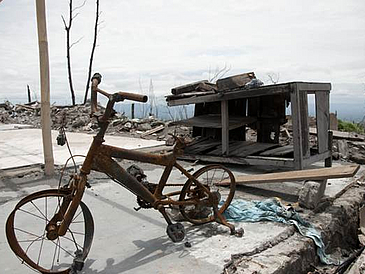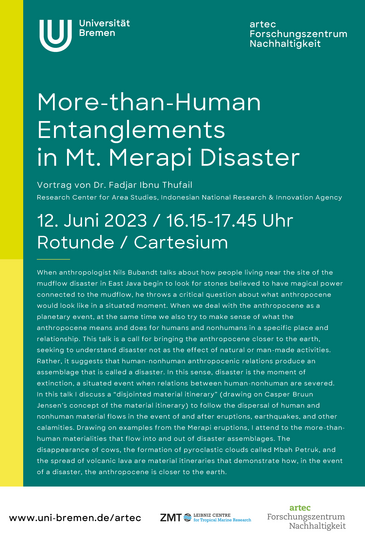Together with the Leibniz Centre for Tropical Marine Research (ZMT), the artec Sustainability Research Center cordially invites you to a guest lecture by Dr. Fadjar Ibnu Thufail:
12.06.2023, 16:15-17:45 | Rotunde, Cartesium
More-than-Human Entanglement in Mt. Merapi Disaster
Dr. Fadjar Ibnu Thufail
Research Center for Area Studies, Indonesian National Research & Innovation Agency
When anthropologist Nils Bubandt talks about how people living near the site of the mudflow disaster in East Java begin to look for stones believed to have magical power connected to the mudflow, he throws a critical question about what anthropocene would look like in a situated moment. When we deal with the anthropocene as a planetary event, at the same time we also try to make sense of what the anthropocene means and does for humans and nonhumans in a specific place and relationship. This talk is a call for bringing the anthropocene closer to the earth, seeking to understand disaster not as the effect of natural or man-made activities. Rather, it suggests that human-nonhuman anthropocenic relations produce an assemblage that is called a disaster. In this sense, disaster is the moment of extinction, a situated event when relations between human-nonhuman are severed. In this talk I discuss a “disjointed material itinerary” (drawing on Casper Bruun Jensen’s concept of the material itinerary) to follow the dispersal of human and nonhuman material flows in the event of and after eruptions, earthquakes, and other calamities. Drawing on examples from the Merapi eruptions, I attend to the more-than-human materialities that flow into and out of disaster assemblages. The disappearance of cows, the formation of pyroclastic clouds called Mbah Petruk, and the spread of volcanic lava are material itineraries that demonstrate how, in the event of a disaster, the anthropocene is closer to the earth.
You can download the event poster here.

![[Translate to English:] Zur artec Startseite](/fileadmin/user_upload/sites/artec/Bilder/Logo/artecWortmarke200px.gif)

